Read Time: 5 Minutes Subscribe & Share
A Sustainable Farming Gem
Hidden off a particularly uninspiring stretch of Richmond Highway is an unexpected agricultural 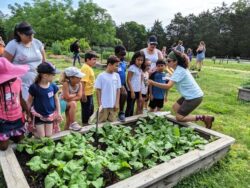 wonderland. Here, tucked behind some faltering interstate enterprises, lies a small but lush expanse of land dedicated to the most up-to-date agricultural and social justice causes. Arcadia Farm, formally Arcadia Center for Sustainable Food and Agriculture, is a nonprofit organization that’s part of Woodlawn Estate.
wonderland. Here, tucked behind some faltering interstate enterprises, lies a small but lush expanse of land dedicated to the most up-to-date agricultural and social justice causes. Arcadia Farm, formally Arcadia Center for Sustainable Food and Agriculture, is a nonprofit organization that’s part of Woodlawn Estate.
It devotes its acreage to easing food inequities and improving nutrition in its Route 1 Alexandria communities — improving food access, reducing food insecurity, and fostering better nutrition in a lower income area where grocery stores are scarce. Staff and volunteers work to bolster local farmers, teach newbies how to become farmers, offer hands-on sustainable farming experiences to children and adults, supply produce to farmers markets in food deserts, and showcase techniques for preserving the environment for future generations. Lofty goals in an unlikely spot.
Quakers Intervene
What’s unexpected is that this enclave dedicated to such progressive aims is a former plantation — once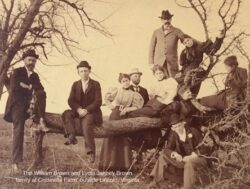 part of George Washington’s Mount Vernon holdings and farmed by 90 enslaved people. Destined to defy plantation stereotypes, two decades before the Emancipation Proclamation, Woodlawn was sold to a group of Quakers, abolitionists who were determined to show the South that a free labor system could work at least as well as slave labor. According to Pam Hess, Arcadia’s executive director (interviewed in 2016 for the Fair Farm website): “They sold plots to free African-Americans, Irish and German immigrants, and other Quakers. They established the mansion as an integrated school for the town’s children and created an integrated militia to protect the citizens. As a ‘free labor zone,’ for the first time in Woodlawn’s history, it was a profitable farming operation.”
part of George Washington’s Mount Vernon holdings and farmed by 90 enslaved people. Destined to defy plantation stereotypes, two decades before the Emancipation Proclamation, Woodlawn was sold to a group of Quakers, abolitionists who were determined to show the South that a free labor system could work at least as well as slave labor. According to Pam Hess, Arcadia’s executive director (interviewed in 2016 for the Fair Farm website): “They sold plots to free African-Americans, Irish and German immigrants, and other Quakers. They established the mansion as an integrated school for the town’s children and created an integrated militia to protect the citizens. As a ‘free labor zone,’ for the first time in Woodlawn’s history, it was a profitable farming operation.”
It Takes a Village To Save Farming
Enduring several cycles of decline and repair, the Woodlawn estate eventually was rescued by the National Trust for Historic Preservation — the first property it purchased to save. Arcadia Farm took root, established partly because agricultural trends have been so discouraging.
According to Arcadia’s website
“ The average age of U.S. farm operators increased from 55 in 2002 to 57 in 2007. In that same time, the number of farmers under 25 decreased by 30%.
- Small farms are disappearing to make room for new developments and large, industrial farm operations.
- Unsustainable farming practices are one of the major factors contributing to environmental degradation like erosion, polluted waterways, and a changing climate.
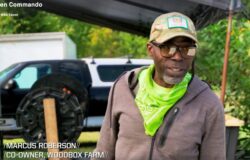 There is a need to engage the farm community, beginning farmers, and the public to show that small-scale, sustainable farming can be economically viable, beneficial to the environment, and a source of healthy food for the community.”
There is a need to engage the farm community, beginning farmers, and the public to show that small-scale, sustainable farming can be economically viable, beneficial to the environment, and a source of healthy food for the community.”
Arcadia’s larger demonstration farm is on one side of Route 1 and a smaller plot, the children’s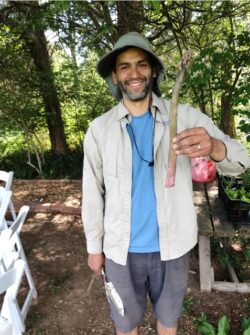 education garden called Hilltop Farm and Groundhog Garden, are on the other side, nestled close to the Woodlawn house. Hilltop is close to my heart, as a spot where I’ve been a happy, inept volunteer for two summers. There I’ve been lucky to be guided by Juan Pablo “JP” Echeverria, Arcadia’s Outreach and Education Manager. JP is the guru who keeps expanding the farm’s education programs, finds partners, and works with nearby schools and communities along the Fairfax County – Route 1 Corridor to help them grow their own food.
education garden called Hilltop Farm and Groundhog Garden, are on the other side, nestled close to the Woodlawn house. Hilltop is close to my heart, as a spot where I’ve been a happy, inept volunteer for two summers. There I’ve been lucky to be guided by Juan Pablo “JP” Echeverria, Arcadia’s Outreach and Education Manager. JP is the guru who keeps expanding the farm’s education programs, finds partners, and works with nearby schools and communities along the Fairfax County – Route 1 Corridor to help them grow their own food.
He has a perfect background for the job. In Guatemala, his home country, JP had co-founded an urban sustainability organization, owned and managed an urban organic farm, owned a bar and restaurant, and was the president of a local public health nonprofit. He also holds a business management degree from Universidad Mesoamericana de Guatemala.
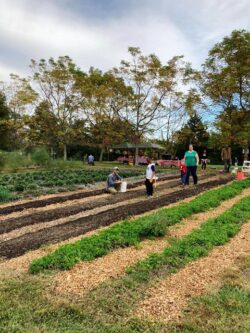 He also deploys the volunteers at Hilltop Farm, and I can attest that he is gifted at managing this piece of his portfolio. I was an especially challenging subject — superannuated, citified, and hampered by big-time back problems. Nevertheless, JP has tutored me in pruning, planting seeds, transplanting seedlings, weeding, fertilizing, egg gathering, and harvesting. Quick tip: fish emulsion is best used to fertilize outside plants. Only outside. JP learned the noxious consequences of using leftovers for indoor house plants and now passes along this hard-won knowledge to all of us. He also patiently taught me how to salvage some straggly, benighted lettuce seedlings that truly deserved a quick trip to the compost heap. They survived to salad-worthiness with his tutelage. Best of all, JP introduced me to the incomparable taste of a piece of asparagus that had just cleared the ground by a few inches overnight. Absolutely mind-bogglingly delicious. I shared that treasure with other volunteers only reluctantly.
He also deploys the volunteers at Hilltop Farm, and I can attest that he is gifted at managing this piece of his portfolio. I was an especially challenging subject — superannuated, citified, and hampered by big-time back problems. Nevertheless, JP has tutored me in pruning, planting seeds, transplanting seedlings, weeding, fertilizing, egg gathering, and harvesting. Quick tip: fish emulsion is best used to fertilize outside plants. Only outside. JP learned the noxious consequences of using leftovers for indoor house plants and now passes along this hard-won knowledge to all of us. He also patiently taught me how to salvage some straggly, benighted lettuce seedlings that truly deserved a quick trip to the compost heap. They survived to salad-worthiness with his tutelage. Best of all, JP introduced me to the incomparable taste of a piece of asparagus that had just cleared the ground by a few inches overnight. Absolutely mind-bogglingly delicious. I shared that treasure with other volunteers only reluctantly.
The Seedlings Of Change
Hilltop plays host to groups of school kids, many of whom haven’t been exposed to food’s origins— not to mention what fresh-from-the-soil kale and sorrel taste like. The Hilltop staff have a special talent for devising activities to get kids to fall in love with gardening — not all of them unqualified successes. I’m 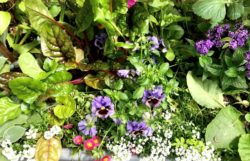 thinking of seed balls, adapted from something JP had learned about “guerrilla gardening.” People had reclaimed an ugly, urban empty lot by coating balls of soil in wildflower seeds and regularly pitching them over the fence. Voila, eventually a meadow bloomed. JP taught his young pupils the technique and sent them home to toss their treasures. Parental complaints ensued. “I gave them all mud balls, pretty much, which didn’t go over very well. Now we have the children toss them on the farm before they leave.” Seed balls now count as a success, even to cleanliness-conscious parents.
thinking of seed balls, adapted from something JP had learned about “guerrilla gardening.” People had reclaimed an ugly, urban empty lot by coating balls of soil in wildflower seeds and regularly pitching them over the fence. Voila, eventually a meadow bloomed. JP taught his young pupils the technique and sent them home to toss their treasures. Parental complaints ensued. “I gave them all mud balls, pretty much, which didn’t go over very well. Now we have the children toss them on the farm before they leave.” Seed balls now count as a success, even to cleanliness-conscious parents.
Arcadia uses only sustainable growing practices, such as cover cropping (crimson clover is beautiful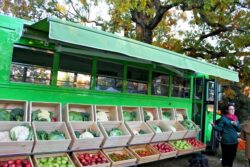 btw!), integrated pest management, low tillage, composting, crop rotation and no synthetic pesticides — not even organic ones. They grow the majority of the produce for Arcadia’s Mobile Market, which provides affordable food to low-income communities with poor access to fresh food. Oh, and they run a well-developed program for service veterans who yearn to become farmers.
btw!), integrated pest management, low tillage, composting, crop rotation and no synthetic pesticides — not even organic ones. They grow the majority of the produce for Arcadia’s Mobile Market, which provides affordable food to low-income communities with poor access to fresh food. Oh, and they run a well-developed program for service veterans who yearn to become farmers.
The US Department of Agriculture estimates we need about 700,000 new farmers over the next decade to replace those leaving the field. Arcadia is a model for filling that gap.

Victoria Sackett is a speechwriter and editor who uses cooking as an antidote to Washington, DC dysfunction. Nothing counteracts chaos like measuring out ingredients in tiny dishes, arranging them in proper order, blending them together, and watching magic happen. Namaste indeed!




Wow! Thank you, Victoria! That was so inspiring! I used to commute to Ft Belvoir and know that whole blighted area. What a wonderful piece to read this morning ☺️